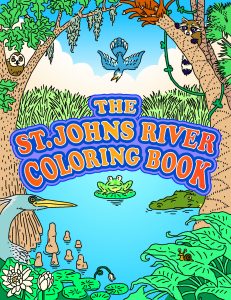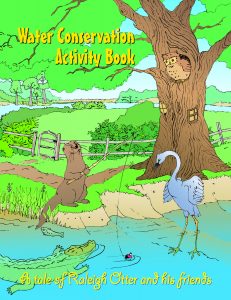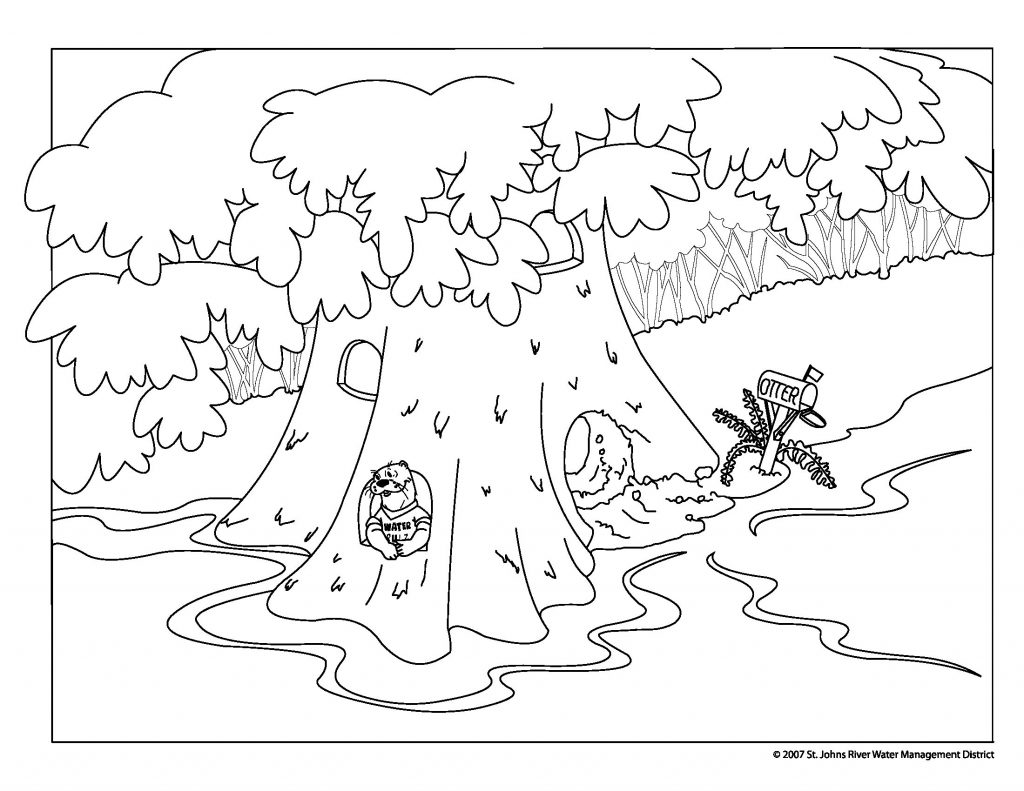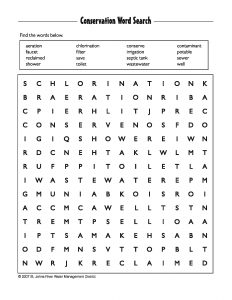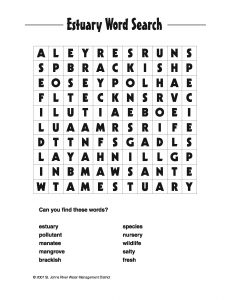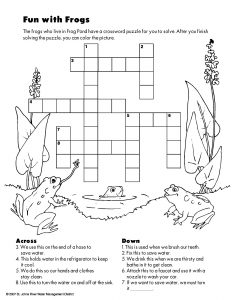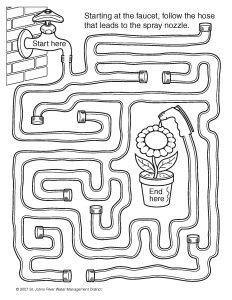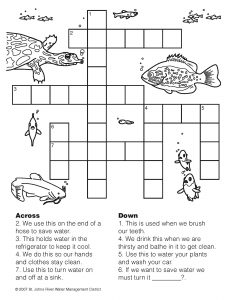Raleigh's Den
Welcome to Raleigh’s Den. Raleigh is a north American river otter who lives in the 18 counties of the St. Johns River Water Management in northeast and east–central Florida. He is one of the creatures who depend on Florida‘s water resources for a home, food and fun.
By exploring the tabs below, you can learn more about river otters, about the work of the water management District to protect and restore Raleigh‘s habitat, play games, see pictures from around Raleigh‘s neighborhood, read stories, and find pages to color and puzzles to solve.
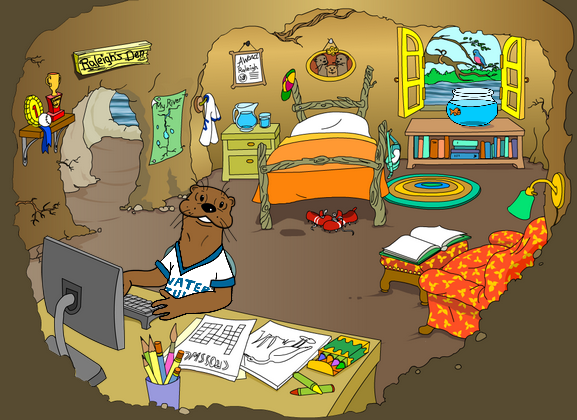
Meet Raleigh
Dear friends,
Hi, I’m Raleigh Otter. I live in the St. Johns River, the river that gives its name to the St. Johns River Water Management District.
You may have seen me or one of my friends splashing around, playing and swimming in one of Florida’s lakes, rivers, creeks or coastal marshes. I have a big family. My relatives (there are 13 kinds of river otters) can be found on five of the world ’s continents.
Many people say that we river otters look like we have a lot of fun. Well, we do. We slide down riverbanks and body surf through the water. We do love the water. In fact, we rarely stray very far from a water body. I also like to chase sticks, play hide-and-seek and roll around in the grass.
River otters’ bodies are made for living in the water, which is where I spend most of my time. I don’t have to wear goggles and swim fins when I go swimming. My nostrils and eyes close and seal to keep water out.
Using my webbed feet and long, thick tail, I swim quickly through the water. I have been known to swim underwater for about a quarter-mile before coming up for air. I can hold my breath for about six to eight minutes. I have even gone as deep as about 60 feet underwater.
I swim a lot differently than fish that you may have seen. Otters move underwater in an up–and–down movement, using our tails to steer. Fish swim side to side. It may not be an Olympic record, but I can swim about 7 miles per hour underwater. If you think that’s fast, I’ve been known to run as fast as 18 miles per hour on land.
In the animal kingdom, we’re not the biggest animals, but we otters are not the smallest either. Most of my Florida relatives and I weigh about 17 pounds and grow to about four feet long, which includes the length of our tails. Some larger otters living in northern part of the United States grow to about 35 pounds.
We otters are the only marine mammals that have fur instead of blubber. Our thick furry hair is nearly black to red or a grayish brown. The fur on my belly is lighter in color – silvery or grayish brown. My fur coat is actually two coats in one; an outer layer of guard hairs and a dense layer underneath that keeps water from soaking through to my skin. In the spring and summer, when you have probably packed away your coat until the cooler weather of fall and winter, I still wear my winter coat; it is with me all the time.
Like you, my Mom has taught me that I should always try to look my best, so you might see me grooming (combing my hair) frequently.
What’s for dinner? I’ve been described as having boundless energy. Like a lot of active young people, I like to eat a lot. My favorites are fish, crustaceans, amphibians, reptiles, birds and insects.
I have to hunt for my food rather than going to a grocery store.
Good thing that I have good eyesight that allows me to see well above and below water. I also have good hearing and sense of smell to find my food. When I am searching for food in dark water or at the river’s bottom, my sensitive whiskers help me find the food.
I don’t hibernate like bears, and I do not store food like squirrels and other animals. This means that I have to hunt all year.
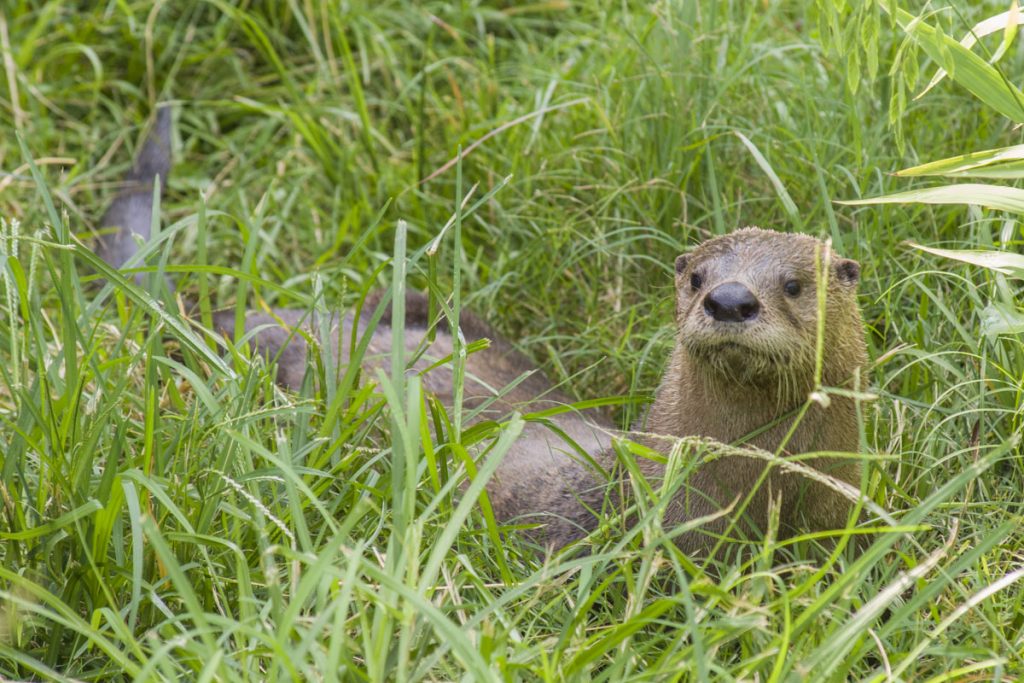
Keeping in touch
My friend Francois (he’s a caterpillar) speaks French and lives in Olliewood. I don’t speak a foreign language, unless you want to count “otter talk” as a foreign language. I talk with my family in a variety of sounds, such as chirps, barks, whistles, grunts, squeals and growls.
Another way that otters communicate is by “marking” our territory with a “scent mark.” We do this using paired scent glands near the base of our tails. These glands produce a very strong, musky odor.
Habitat sweet habitat
My home is not what most people think of as a home. Some people call my home a “den” and some call it a “holt.” Whatever you call it, my home is usually dug into a riverbank or hollow log. My front door is an underwater main entrance, leading to a small space above the level of the water, with several holes in the ceiling to allow air inside and for emergency exit.
A new generation
When I was a baby, or what some people call a “pup,” my Mom watched over me very carefully.
Otter pups are born weighing about 4 to 5 ounces and are blind and toothless at birth. We may not open our eyes for five weeks after birth and our mother keeps us in the den for three or four months. It’s a good thing too. Baby otters are quite helpless for about two months.
When we do venture out of the den, one of the first things our mothers do is to teach us to swim. Our mothers carry us to the water or push us into the water.
My Mom swam under the water and stayed nearby as I first tried to swim. When I got tired, she let me crawl on her back to rest and get my nerve up to try again to swim.
Until we are about a year old, we live with our parents, but are on our own after that.
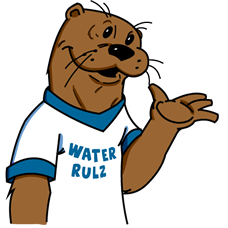
Just the facts
- Common name: North American river otter
- Scientific name: Lontra canadensis lataxina
- Family: Mustelidae
- Order: Carnivora
- Class: Mammalia
- Range: North America, from the edge of the Arctic to the Gulf of Mexico. River otters have very large home ranges and are constantly on the move within this range. Despite the sizeable area, river otters are territorial but generally practice mutual avoidance. In their travels on land, river otters cover as much as 55 miles each year. Habitat: inland waterways, estuaries, and marine coves
- Description: body length, 2 to 3.5 feet; tail length, 1 to 1.5 feet; average weight is approximately 17 pounds; short legs, powerful jaws and sharp teeth; nose is diamond-shaped, with two nostrils at the lower half; wide, round head with small ears; long, thick whiskers
- Life expectancy: in the wild, up to 16 years; up to 23 years in captivity. Sexual maturity is reached at 2 to 3 years of age.
- Behaviors: River otters are usually found alone or in pairs, but they often socialize in larger groups. This species is often referred to as “playful.” Many play activities actually serve a purpose. Some are used to strengthen social bonds, to practice hunting techniques, and to scent mark. They are too swift and agile to be caught in the water. They are able fighters if cornered on land. They are strong, have good reflexes and endurance, sturdy teeth and powerful muscles. Otters are mainly nocturnal, but occasionally venture out during the day.
- History: North American river otters were once found from Alaska to Florida. Native Americans hunted otters for their dense fur, which enabled them to keep warm. European settlers also hunted them for fur and developed the land, cutting down forests and habitats. By the 1980s, 11 states reported no otter population and 13 other states reported scarce numbers.
Otters in school
I don’t want to brag, but otters are pretty smart. I’ve made the grade as a unique fellow in the animal world. People say we are very smart because we know how to use tools. For example, we have used rocks to smash open clams, mussels and other shelled prey.
Sharing our world
Because we live in the water, otters are directly impacted by water pollution. Florida has many otters, but they are endangered in some parts of the United States due to hunting and loss of habitat. Our primary enemies are water pollution, air pollution, pesticides, destruction of our neighborhoods (our habitat) and hunters.
At one time, we were considered to be near extinction, but are making a comeback through the efforts of concerned individuals and environmental agencies.
Fortunately, as people act to protect our world’s water resources, our homes are preserved.
The next time you see me, or one of my friends or relatives, in one of Florida’s waterways, I hope you’ll wave and say hello.
Signed,
Your friend,
To learn more about my relatives, check out some of the cool websites that have information devoted to river otters:
Raleigh

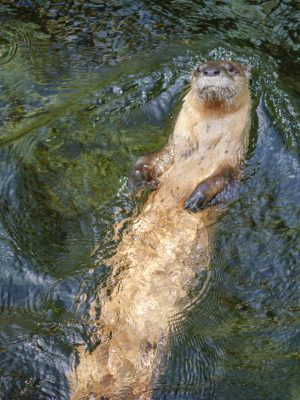
Raleigh’s sources include:
- Jacksonville Zoological Gardens, Jacksonville, Fla.
- “Wildlife Note,” Pennsylvania Game Commission, Bureau of Information and Education, Department AR, 2001
- Florida Fish and Wildlife Conservation Commission Web site, The North American River Otter (Lontra canadensis), James Call, 2003, as reprinted from Florida Wildlife magazine, May/June 2001 edition.
To learn more about my relatives, check out some of the cool websites that have information devoted to river otters:
What is water management?
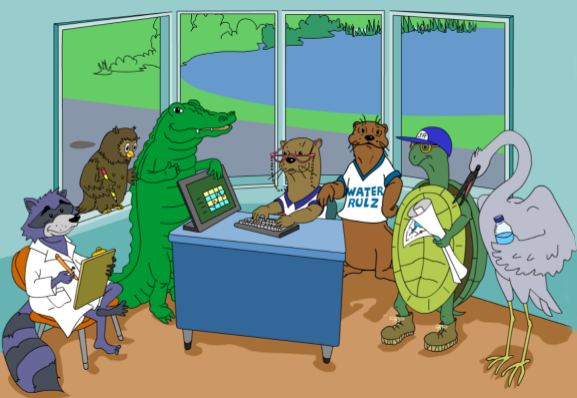
Raleigh Otter’s mother, Sallie Otter, works for the St. Johns River Water Management District. Her office is at its headquarters in Palatka, Fla. Raleigh thinks his mother has a cool job because her job is all about water, and Raleigh loves the water!
Sally Otter
Mrs. Otter is an environmental scientist and enjoys her job because it allows her to work outside many days. Her favorite part of her job is when her work takes her to the St. Johns River or one of the smaller rivers and creeks that flows into the St. Johns River. When she gets to work outdoors, she takes water samples that she sends to the laboratory, where the water is tested to determine if it is healthy water.
Some days after school, Raleigh stops by his mother’s office to see the work that she is doing.
The people who work with Raleigh’s mother have many different things to do every day. Their work includes setting rules for water use, conducting research on water quality and quantity, collecting water use and water quality data, and restoring and protecting water above and below the ground.
When Raleigh visits his mother’s office, he always takes time to talk to other people who work in the office and enjoys the times when he gets to help out.


Alice Alligator
Alice Alligator spends a lot of time in her garden during her spare time, helping everyone to learn about waterwise landscaping. But, during the business day, she and her staff provide the computers and software that staff need to write reports, prepare financial documents, develop the models that track rainfall and water use, and prepare artistic outreach messages to keep the public informed of the District’s work.
Harriett Heron
Harriett Heron and her group are responsible for making sure that there will be plenty of clean, fresh drinking water around for Raleigh and his friends for years to come. Mrs. Heron works with staff members to make sure that people use just the water they need. Raleigh and his friends need water to drink, take baths, cook food and to play in. Others need water to make the products that we use in our homes and businesses.


William W. Owl
William W. Owl watches over the finances of the District. He’s an accountant who makes sure that money is available to buy the equipment and office supplies that the scientists and other District staff need to do their jobs. At the same time, he makes sure that everyone spends the money wisely and properly follows the rules for making purchases.
Ramon Raccoon
Ramon Raccoon works in the District’s laboratory. When Raleigh helps Mr. Raccoon, he watches the scientists mix chemicals with water samples to learn what toxins or other bad substances might be in the water samples. Raleigh has decided that his time in the laboratory is a bit like Halloween because he puts on safety goggles, a lab coat and rubber gloves for protection. Raleigh has also gotten to see the boat that the scientists use to ride on the river to collect water samples. Mr. Raccoon’s co–workers are scientists who study substances that pollute water, learn where those substances come from, and make water bodies healthy.


Tom Turtle
Tom Turtle is a land manager who loves his work because he gets to spend time outdoors, enjoying nature and protecting the plants and animals. Some days he counts the different kinds of animals living on public lands. Some days he helps a crew of firefighters who carefully set fires to burn off undergrowth – known as prescribed burning – to get rid of forest fuels that could burn very hot and uncontrolled in a wildfire.
River facts
Hi kids! Welcome to my river facts photo gallery. Some of my friends at the St. Johns River Water Management District took these cool pictures of my river.
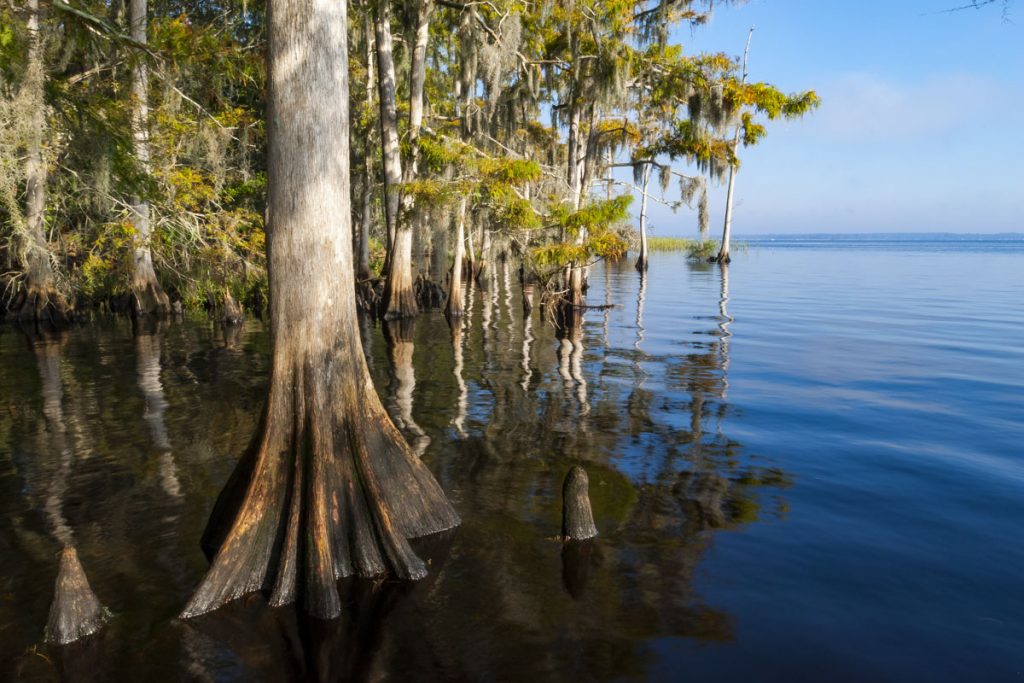
The St. Johns River is the longest river in Florida – 310 miles. It is one of the few rivers in the United States that flows north.
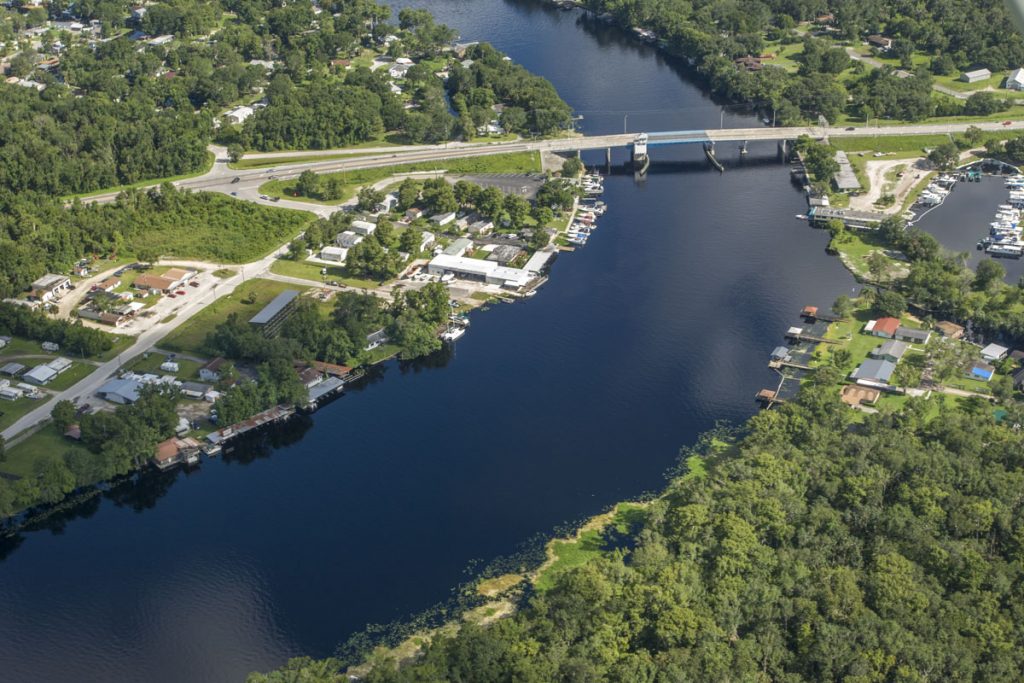
The land area that drains into a water body is called a drainage basin, or watershed. The St. Johns River is divided into three drainage basins.
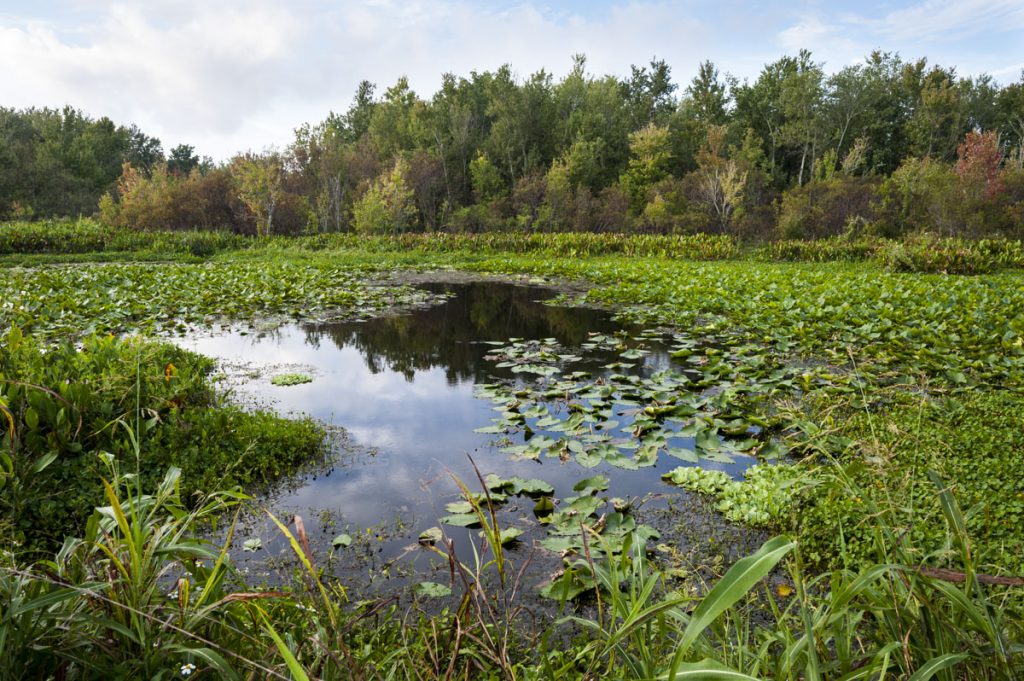
Because the river flows north, the upper basin is the area to the south that forms its marshy headwaters in Indian River and Brevard counties.
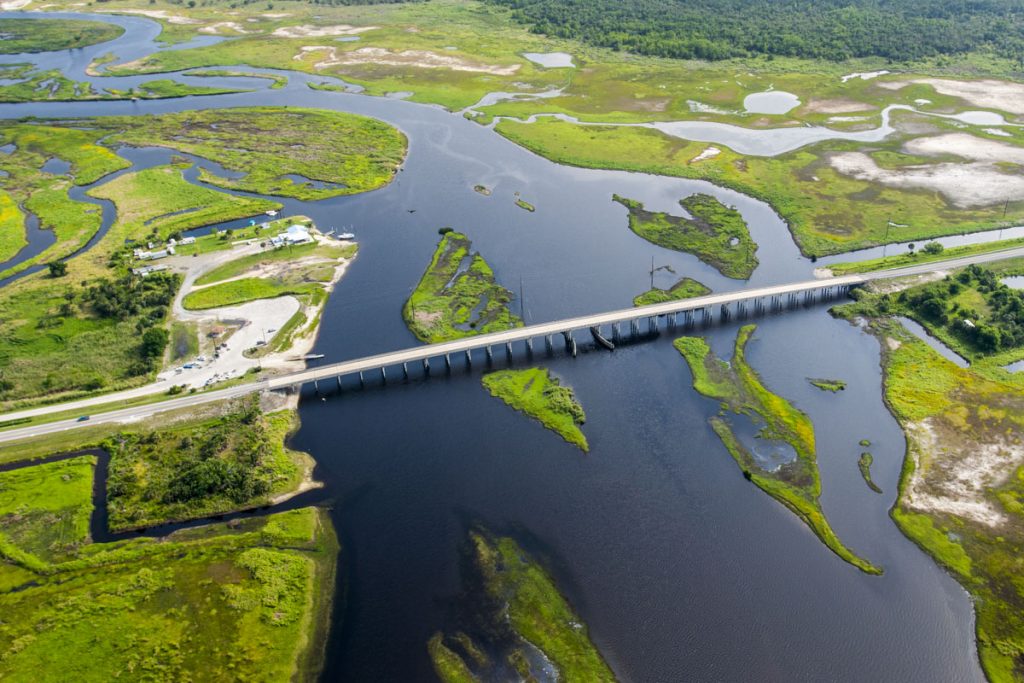
The middle basin of the St. Johns River is the area in central Florida where the river widens, forming lakes Harney, Jesup, Monroe and George.
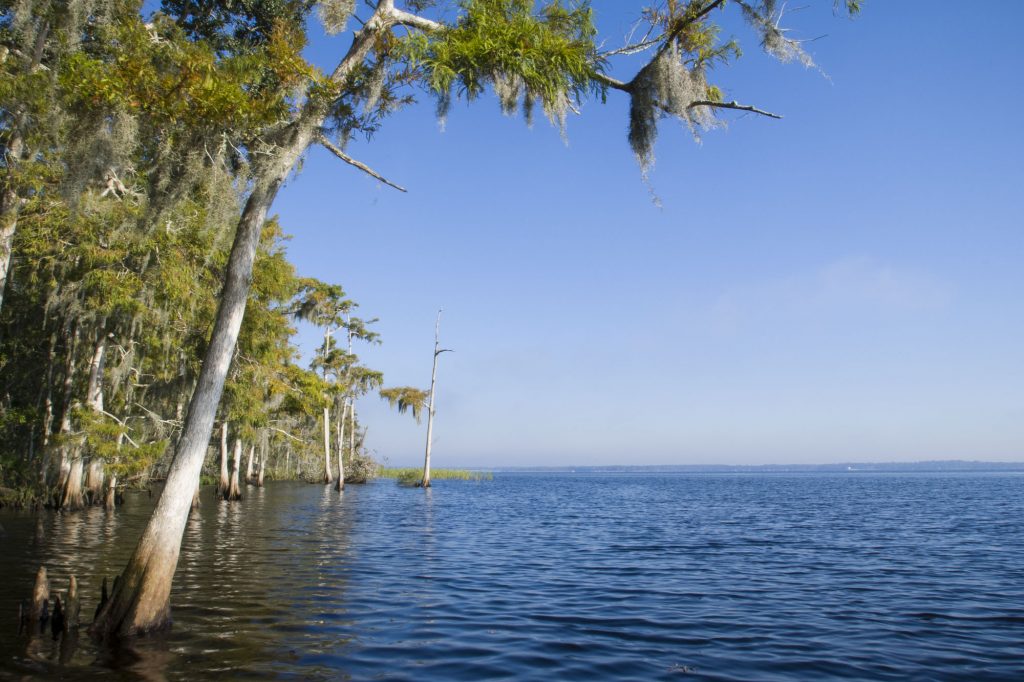
The total drop of the river from its source in marshes south of Melbourne to its mouth in the Atlantic near Jacksonville is less than 30 feet, or about one inch per mile, making it one of the laziest rivers in the world.
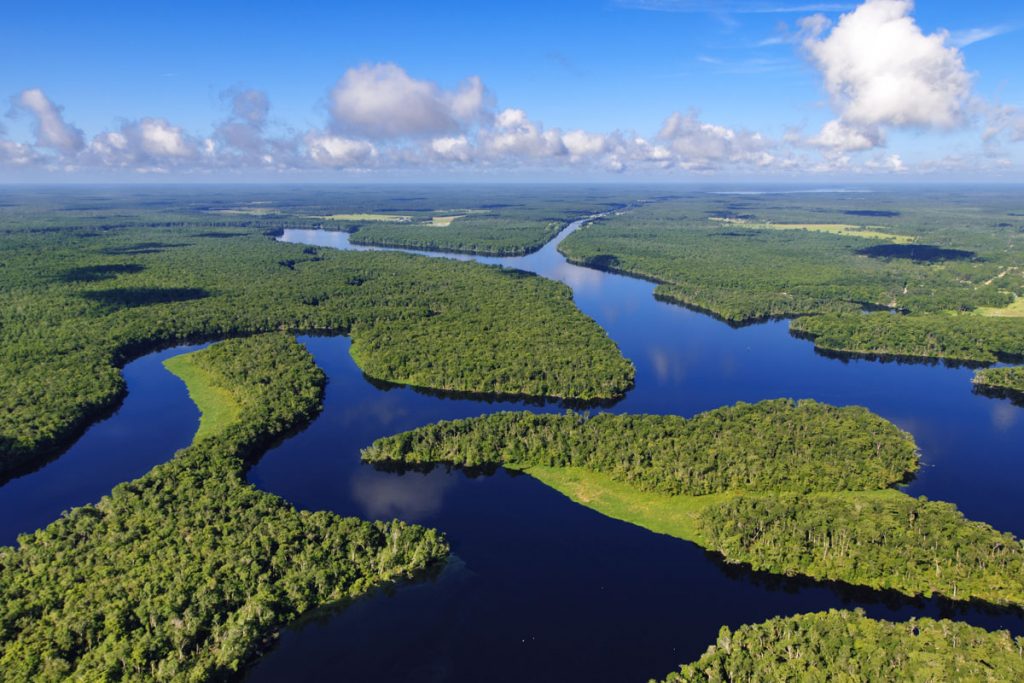
The middle basin of the St. Johns River is the area in central Florida where the river widens, forming lakes Harney, Jesup, Monroe and George.
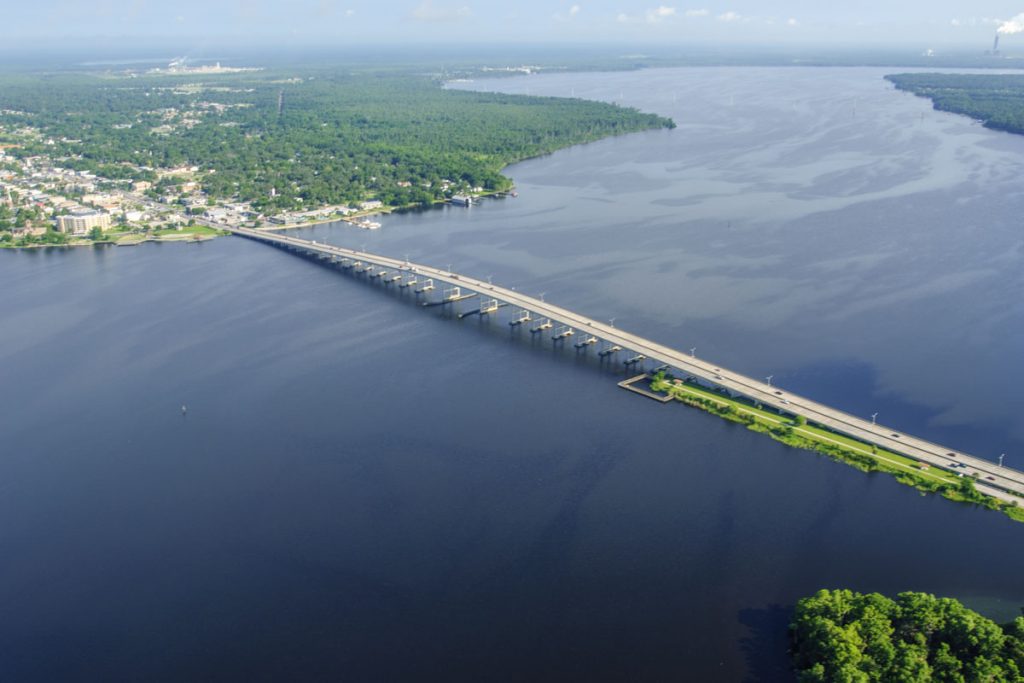
The lower basin of the St. Johns River is the area in northeast Florida from Putnam County to the river’s mouth in Duval County, where the river empties into the Atlantic Ocean.
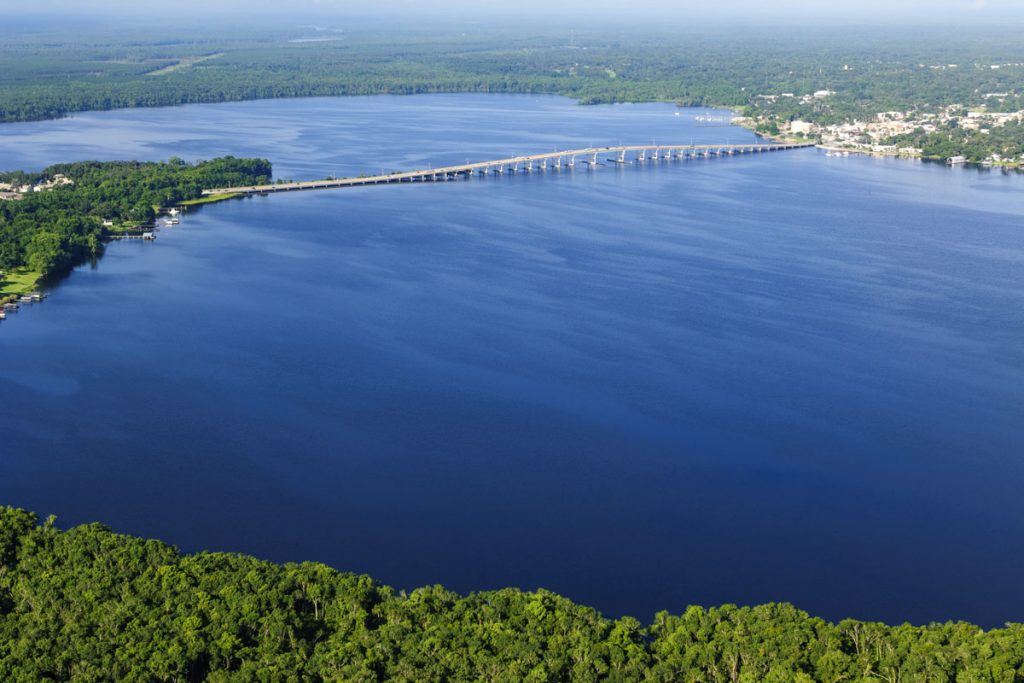
The width of the river varies. It is a flat marsh at its headwaters and averages about 2 miles in width between Palatka and Jacksonville. It widens to form large lakes in central Florida.
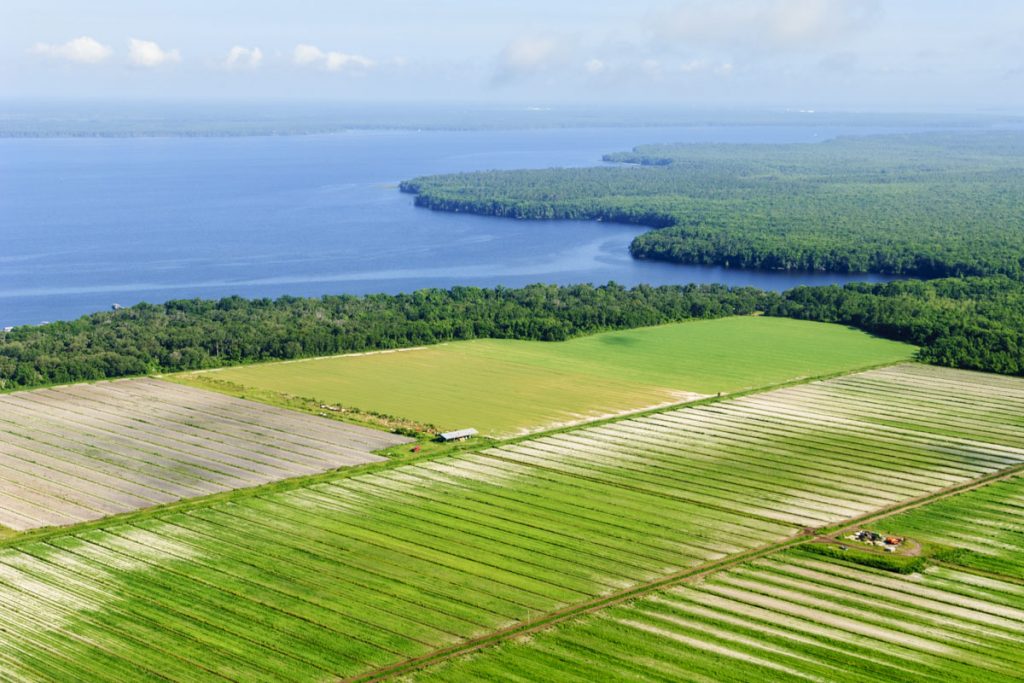
The total drop of the river from its source in marshes south of Melbourne to its mouth in the Atlantic near Jacksonville is less than 30 feet, or about one inch per mile, making it one of the laziest rivers in the world.
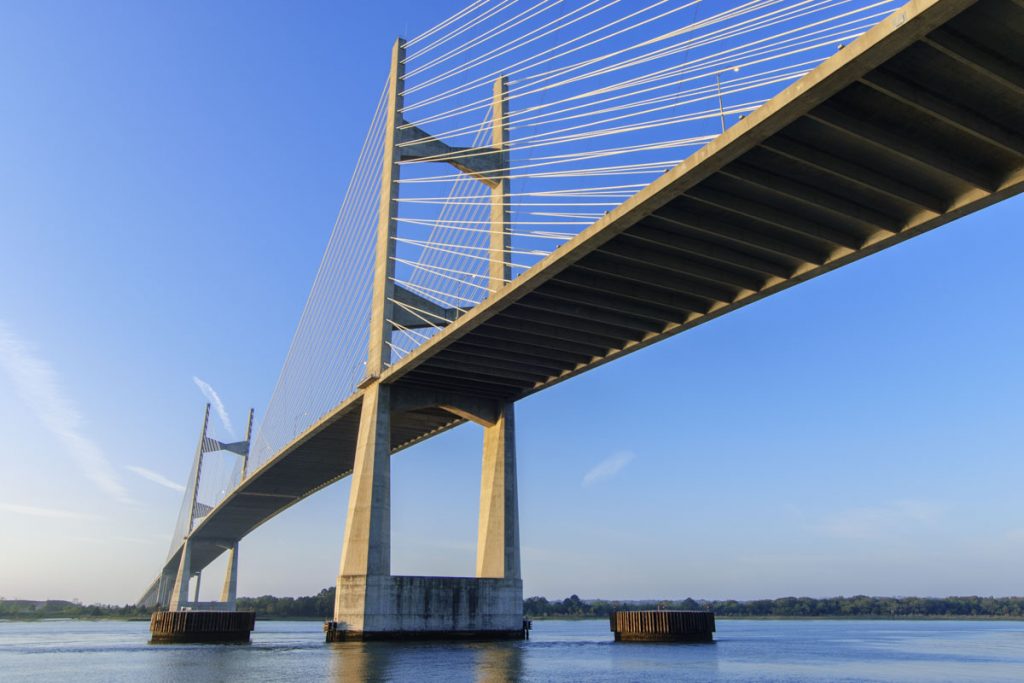
Salt water enters the river at its mouth in Jacksonville. In periods of low water, tides may cause a reverse flow as far south as Lake Monroe – 161 miles upstream from the river’s mouth
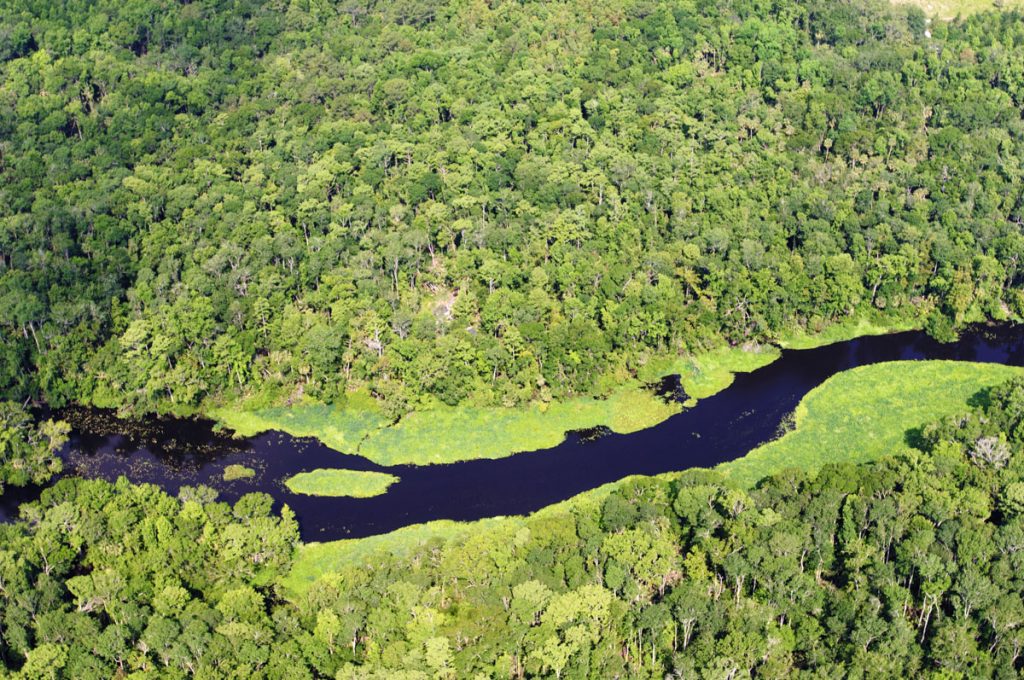
Major tributaries and smaller streams and rivers that flow into the St. Johns River include the Wekiva River, the Econlockhatchee River and the Ocklawaha River.
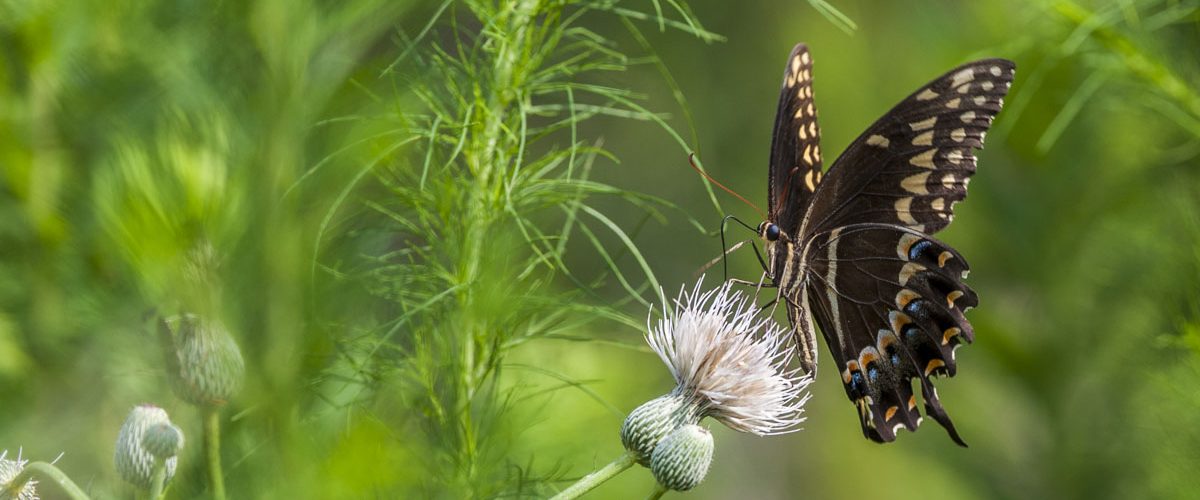
Rainer and the butterfly house
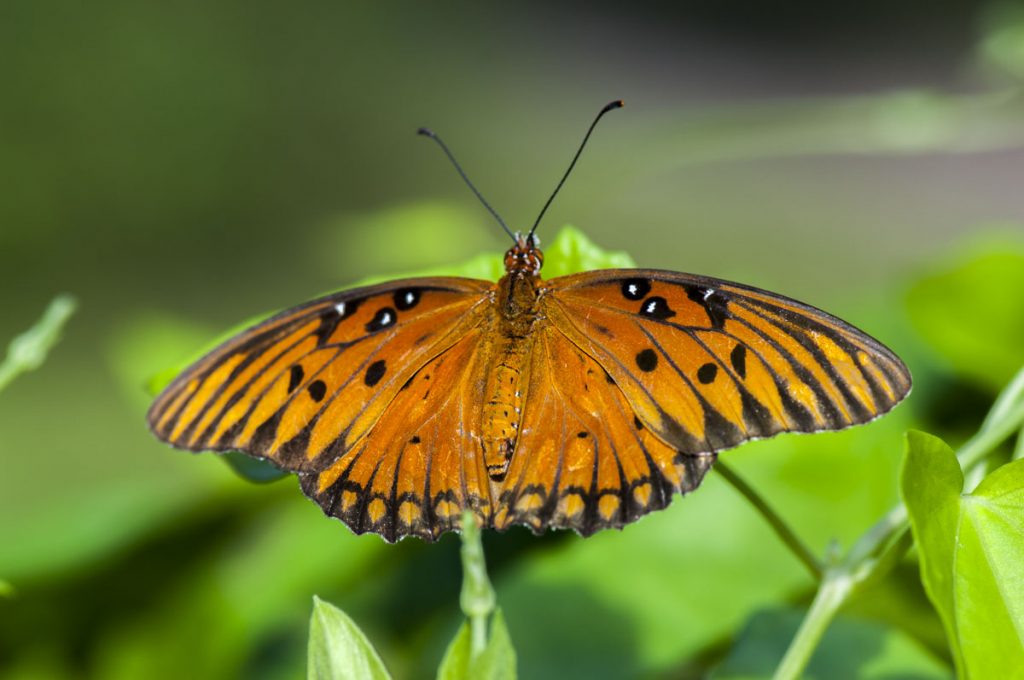
As part of a science project at school, Rainer’s class is developing a plan for creating a water–conserving garden. The garden will be located next to the playground behind the school. The class already decided that it wants to attract butterflies to the water–conserving garden. Now the students need to learn more about creating a habitat for butterflies. The class decided to take a field trip to the public gardens.
Rainer and his classmates followed a tour guide along the winding path through the maze of separate garden areas. They looked all around and made notes in their journals.
The tour guide stopped frequently to tell them about each of the areas.
“All the trees, shrubs, plants and ground covers that we use for landscaping are native to the area and they don’t need much water,” said the guide. “Everything you see in the landscape is well–suited to our natural conditions and climate.”
Just then, the tour guide noticed Emma closely watching the hundreds of butterflies fluttering around the orange, red, yellow and purple flowers that filled part of the garden.
“Butterflies are attracted to flowers with strong colors,” the guide told Emma. “They also like flowers that are very fragrant, because butterflies have a sensitive sense of smell. The butterflies search for sun–loving plants that can serve as good hosts on which they can lay their eggs.” “Are those butterflies drinking water?” asked Katie as she pointed to a group of butterflies around the edge of a small puddle.
“Yes, there are some butterflies that cannot survive on a diet of nectar alone. There are certain minerals that these butterflies need that are found in standing water or mud puddles. Creating a mud puddle or two in your garden is just another way of attracting butterflies to your garden,” said the guide.
“Do you have to use a lot of chemicals to keep insects out of the gardens?” asked Rainer.
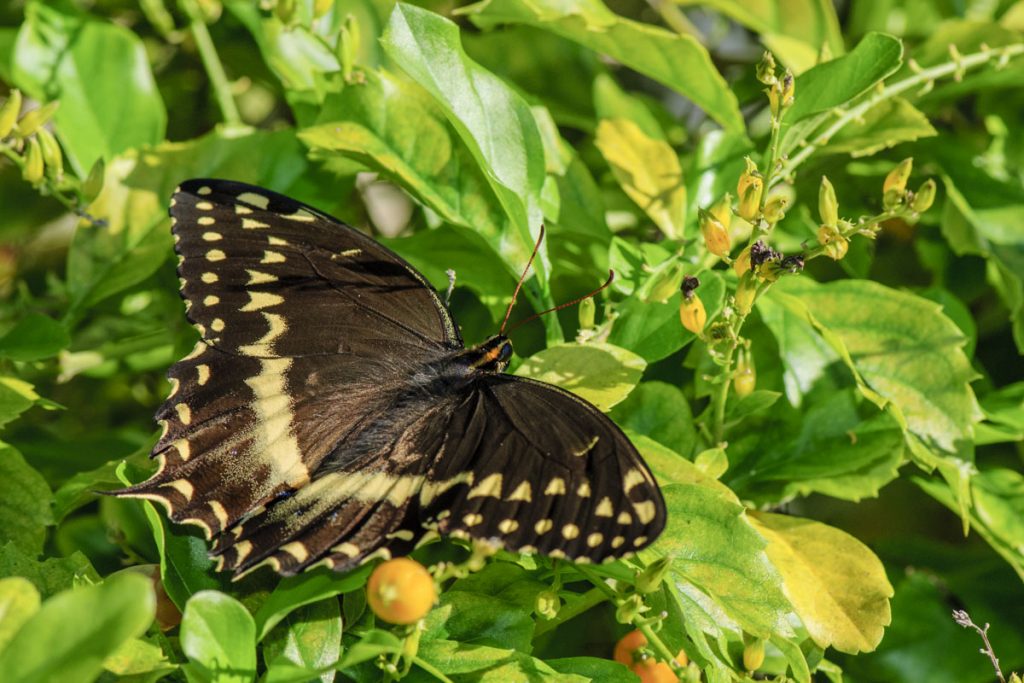
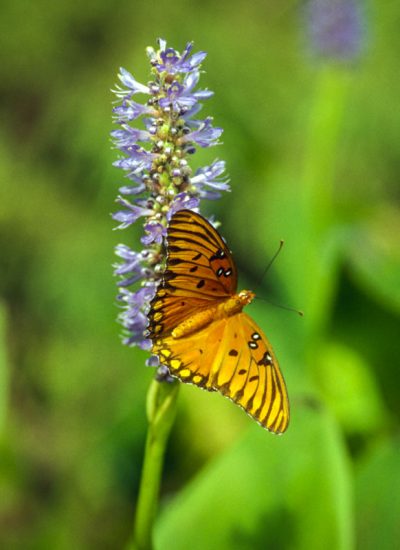
“Oh, no,” replied the guide. “We don‘t use any chemicals. If we did, we wouldn‘t have any butterflies. This is an environmentally friendly garden where we don‘t depend on fertilizers and chemicals to create attractive landscapes.”
“Wow! That tree limb over there is covered with butterflies,” said Derrick.
“Those are monarch butterflies,” said the guide. “They are often called the ‘wanderers’ because they travel so far. Every year, hundreds of millions of them fly from the eastern part of the United States to Mexico. The trip may be more than 2,000 miles.
The monarchs sometimes use Florida as a resting place before flying across the Gulf of Mexico.”
“If I had to fly that far, I would need a rest too,” said Emma.
The students continued their walk through the gardens. They saw butterflies of many different colors, shapes and sizes. Butterflies seemed to be everywhere.
At the end of the walk, the guide made the following suggestion to the students:
“Remember, you have only taken the first step in learning about butterflies and environmentally friendly gardens,” said the guide. “You can continue to discover more by visiting other gardens, going to the library, using the Internet and creating your own garden.”
The students thanked the tour guide for their visit and returned to school to begin planning their garden.
Note: This story was first published in “Water Drops” by the Southwest Florida Water Management District and is republished with permission.
The Story of Betty Moo
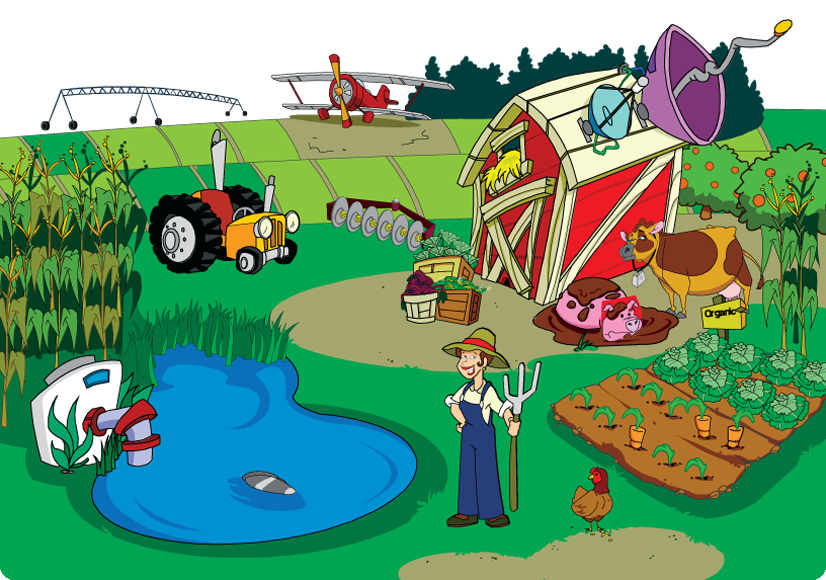
It was a calm morning, and the cows munched happily on the dew-soaked grass. A fog rolled lazily through the trees. Jesse walked out to the pasture to say good morning to her favorite cow, Betty Moo. Jesse had just learned to whistle and was practicing with an old song her father had taught her.
“You sure got it figured out, Betty,” said the girl. “You just lay around all day, eating and sleeping, as if you don’t have a care in the world.”
Betty Moo didn’t respond; she just strolled over to the watering trough and drank the cool, fresh water. Jesse saw this and realized that she was thirsty too. She said goodbye to Betty Moo and started to walk back to her house to get a glass of water. She looked across the fields as she walked. They were planted with cabbage and potatoes and seemed to go on forever.
That night at dinner, Jesse jokingly told her father that she wanted to be a cow when she grew up, just like Betty Moo. Her father smiled and played along. “A cow?” he said, “Why’s that?” “It just seems so easy,” replied the girl. “They just lay around all day and eat grass.”
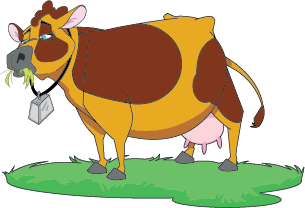
“Well, it’s easy for them because we take care of them,” said her father. “Like many other things in nature, Betty Moo depends on us. Do you know what stewardship is?” “No,” said Jesse, scrunching up her face and trying to think. “What’s that?”
“Stewardship means taking good care of something that you have responsibility for. As farmers, we impact the land we farm and the animals on and around it. One of our responsibilities is to make sure that we don’t harm nature while growing food for people to eat.” “I don’t understand,” said the girl. “How could we harm the land?”
“Well, you were probably too young to remember when we bought this farm,” said the father. “Betty Moo and a few other cows were here, but they didn’t have it as good then as they do now.”
Jesse smiled because she realized her father was going to tell a story. It was winter, a few weeks after the family had bought the farm. The farmer and his wife stood by their truck and looked out over the fields.
“So this is it,” said the wife. “It needs work, but I like it.” It certainly did need work. The cows were standing in mud up to their knees and drinking from the same stream the previous farmer often used for dumping waste. Not only was the stream cluttered with debris, but it was also bright green and choked with algae. This told the farmer that the fields had way too much fertilizer on them, and rain was washing that fertilizer into the stream.
Not only were the cows miserable, but the farm’s neighbors also had to deal with the erosion and pollution downstream.
“Here they are,” said the wife, as a blue truck bumped toward them on the dirt road. It had the words St. Johns River Water Management District on the side. A woman got out of the truck when it stopped.
The woman smiled at the farmer and his wife.
“I’m with the District,” she said. “We talked on the phone.” She was there because the farmer had asked to meet with someone from the District to discuss best management practices. He wanted to clean up the farm.
The woman from the District tested the soil and confirmed what the farmer had thought. The farm’s soil was over fertilized, and excessive fertilizer from the farm was going into the stream. The woman from the District suggested several best management practices that could help. She explained to the farmer that best management practices grow healthy plants, with less water and fertilizer. This saves water and keeps pollution out of surface waters.
After the woman from the District left, the farmer decided to begin implementing the best management practices immediately.
First, the farmer installed water control structures. Throughout the farm, ditches collected the water that ran off the fields and it washed into the stream. The water control structures blocked the ditches to hold the water back. This helped conserve water and kept the fertilizer-rich water on the fields, where it could help the crops grow, instead of running into the stream.
When it came time to plant, the farmer planted corn and beans in some of the fields, adding variety, not just cabbage and potatoes. Alternating crops in a field helps to improve the productivity of the soil while reducing the risks of insects and plant disease. Corn and beans also need less fertilizer to grow, so the farmer didn’t need to use as much. This meant that less fertilizer would wash into the stream.

To keep animal waste out of the stream, the farmer built a fence to keep the cows out of it. He built a pond with a water trough and gave the cows clean water. Grass soon began to grow on the steep stream banks, reducing erosion and filtering rainwater.
The farmer seeded the cows’ pasture to eliminate the mud. He rotated the grazing cows into different pastures throughout the year. He also began collecting and storing manure to use as fertilizer. The cows were happy, and less sediment and pollution was washing into the stream.
Finally, it came time to put fertilizers on the fields so the farmer’s crops would grow. The farmer knew that excess fertilizer washed off the fields and into the stream in the rain, and he wanted to keep the stream clean. So, he used only as much fertilizer as he needed.
When he was done, the farmer looked out over the farm and smiled. As he did this, one of the cows ambled up next to him. The farmer looked at the cow. He thought the animal looked happier and, perhaps, was even thanking him.
“You’re welcome, Betty,” he said. “Yeah, that’s a good name for you. I think I’ll call you Betty Moo.”
As the farmer finished the story, his daughter looked out the window. The sun was setting, and Jesse could see the stream that ran along their farm. She spent a lot of time playing beside that stream, and it made her sad to imagine it polluted. She could also see the cows in the distance, including Betty Moo.
“So it’s up to us to keep our land healthy and productive,” Jesse said.
“Yes, but it’s bigger than that,” replied Jesse’s father. “Our stream runs into the river a few miles from here, and we keep the river healthy by doing our part. Like everyone else, on a farm or in a city, the things we do affect everyone’s water resources. It’s a pretty big responsibility.”
Suddenly, the father chuckled. “But you won’t have to worry about that if you’re a cow,” he said.
Jesse shook her head. “I don’t want to be a cow anymore,” she said. “I’d rather be a steward like you. I think I will be a farmer when I grow up.”
Protect our watershed
When Paul, Todd, and Maggie arrived at the park, they quickly got off their bikes. Then they locked them to the bike rack next to the path that led to the wetlands and Parkside Pond.
Maggie looked at the big sign posted at the path entrance and read it aloud. “Protect your watershed. Come to the pond cleanup on Saturday!”
“What’s a watershed?” asked Paul. “I can see the damp, soggy wetlands and the pond, but I don’t see a shed anywhere.”
“It’s an area where water collects and then sometimes moves to a bigger body of water,” said Maggie. “My teacher says that we all live in a watershed. She said to think of a watershed sort of like a neighborhood. That’s because everyone who lives in a watershed should help take care of it.”
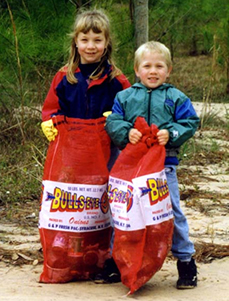
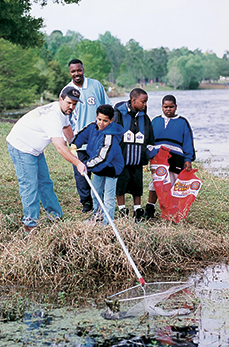
Paul thought about it for a moment and then asked, “Is Parkside Pond part of the watershed?”
“Yes, absolutely,” said Maggie. “The wetlands near the pond are part of the watershed too. And so is the creek that runs by the pond that feeds into the stream, which flows into the river that’s a few miles away.”
River clean up
“Whew! That’s a lot of different water bodies,” said Paul. Todd pointed at the puddle next to his bike and asked, “Is the puddle part of the watershed?”
“Yes, even the puddle,” said “It’s a mini-watershed. The water collects there and either flows to a bigger water area, soaks into the ground, or evaporates.”
As Paul, Todd, and Maggie began walking on the path that led them by the wetlands and toward the pond, they quickly understood why a cleanup was scheduled to take place.
When they arrived at the edge of the pond, Paul exclaimed, “This place is a mess!” Several soda cans and bottles littered the shallow shallow water. A few empty motor oil cans could be seen in the bushes nearby. An abandoned kite, several plastic cups, and a variety of candy wrappers floated near a group of water lilies. An old fishing pole with its hook and line still attached was wedged between two rocks in the water.
“Look over there!” exclaimed Todd. “Someone even left an old bicycle tire. What do people think this is, the city dump? People who do this aren’t being very good watershed neighbors.”
It was clear to all three of them that people who visited the area had created this horrible condition. They looked at each other and sighed. Then they continued walking around the pond and silently thought about how people’s actions can harm the environment.
“What do you think all this nasty stuff does to the water?” asked Paul.
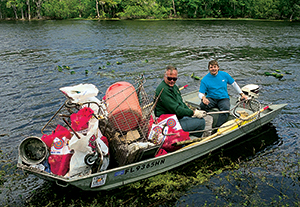
“It makes it unhealthy, that’s for sure,” responded Maggie. “I bet the fish don’t appreciate trying to survive among all these pollutants. Just think about what happens to the creatures that live in the wetlands. Not to mention what happens when water overflows into the creek, the stream, and finally the river. All those areas become polluted too.”
“I’m glad there is a cleanup on Saturday,” said Paul. “We need to let others know about it too.”
“It’s going to take the help of a lot of volunteers to clean this place up,” said Todd.
“Let’s tell all of our neighbors and encourage them to come to the cleanup,” said Maggie. “After all, a watershed is like a neighborhood. And it’s everyone’s responsibility to keep it clean and healthy.”
Note: This story was first published in “Water Drops” by the Southwest Florida Water Management District and is republished with permission.
Coloring books and pages
When Raleigh has finished his homework, he enjoys coloring. Some of his favorite things to color are pictures of the St. Johns River and tales of his adventures with his friends. Click on the images of the color sheet and coloring book to open the books. Then use the print function (under the “file” menu) on your computer to print a paper copy to color at home. Have fun!
Word puzzles
Challenge yourself with these puzzles that Raleigh and his friends have created. Click on the image to open a puzzle. Use the “print” function on your computer to print the page. Then, fill in the information.


